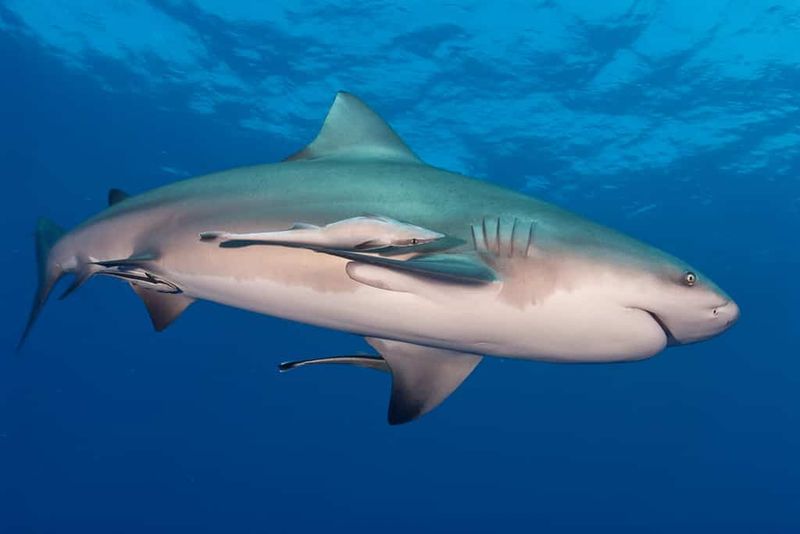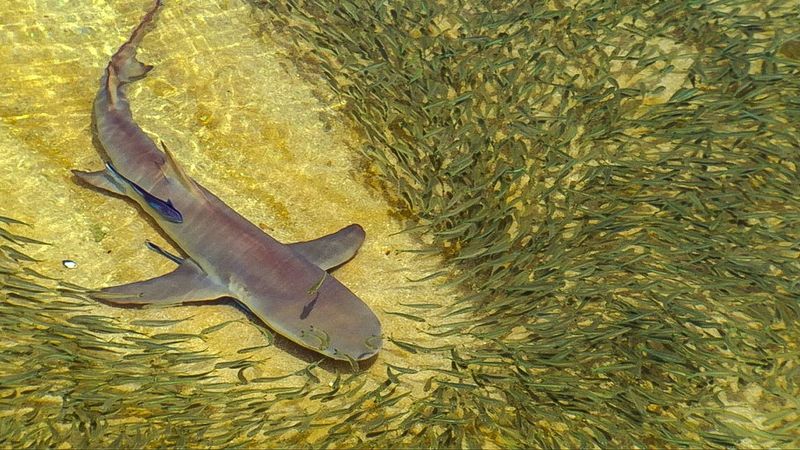8 Surprising Facts About Mississippi River Sharks (And 6 Key Differences From Ocean Sharks)

Imagine swimming in the mighty Mississippi River and spotting a shark fin cutting through the murky water!
While rare, bull sharks can indeed navigate from the Gulf of Mexico into freshwater rivers, including the Mississippi. These incredible creatures have adapted in fascinating ways to survive in environments vastly different from their ocean-dwelling cousins.
1. Salt-Free Survivors

Bull sharks possess special kidneys that can recalibrate their bodies to handle freshwater environments. Unlike most sharks that would die in freshwater, these remarkable creatures can swim more than 2,000 miles upstream in the Mississippi River!
Scientists call this ability ‘osmoregulation,’ which allows them to maintain proper salt balance regardless of their surroundings. This evolutionary superpower makes them uniquely dangerous among shark species.
2. Record-Breaking River Journeys

The farthest documented Mississippi River shark sighting occurred near Alton, Illinois—a staggering 1,750 miles from the Gulf of Mexico! This 1937 discovery shocked locals and scientists alike.
River sharks don’t just visit briefly; they can potentially live in freshwater for years. Their incredible stamina and adaptability allow them to navigate through locks, dams, and changing river conditions that would stop most marine predators in their tracks.
3. The Pregnancy Phenomenon

Female bull sharks often journey into rivers specifically to give birth! The freshwater environment provides protection for their pups from larger ocean predators that can’t follow them upstream.
A single mother can deliver between 1-13 pups in these riverine nurseries. This clever reproductive strategy helps ensure higher survival rates for their young, though it sometimes brings the sharks into closer contact with humans.
4. Dinner Time Differences

Mississippi River sharks adapt their hunting techniques to their surroundings, focusing on catfish, carp, and other freshwater species instead of their usual oceanic prey. Their powerful sense of smell compensates for reduced visibility in muddy river waters.
They become opportunistic ambush predators in rivers, using the murky conditions to their advantage. Interestingly, they’ve been known to develop preferences for certain river prey, showing remarkable dietary flexibility.
5. The Shape-Shifting Ability

River sharks actually undergo physical changes when transitioning to freshwater! Their dorsal fins may appear slightly different, and their coloration often becomes lighter to blend with the brownish river environment.
Long-term freshwater residents develop more robust livers to help process the different water chemistry. Scientists have observed these adaptations happening within weeks of river entry, showcasing these sharks’ remarkable biological plasticity.
6. Seasonal River Residents

Bull sharks don’t randomly venture into the Mississippi—they follow specific seasonal patterns! Peak river-shark season typically occurs during warmer months when water temperatures rise above 70°F.
Spring flooding creates perfect conditions for upstream travel as barriers become easier to navigate. Local fishermen along the lower Mississippi have passed down knowledge of these patterns for generations, knowing exactly when to expect these toothy visitors each year.
7. The Sneaky Navigators

Mississippi River sharks navigate through complex river systems using Earth’s magnetic field and chemical cues in the water. Their specialized ampullae of Lorenzini—jelly-filled pores around their snouts—detect minute electrical signals from other animals and geographic features.
This built-in GPS system helps them find their way back to the ocean when needed. Remarkably, some tagged individuals have shown evidence of memorizing routes through the river system, returning to the same spots year after year.
8. Historical Shark Encounters

Native American tribes along the Mississippi recorded shark encounters long before European settlers arrived! The Natchez people included river shark imagery in their artwork and oral traditions, showing these creatures have been river residents for centuries.
Mark Twain even mentioned Mississippi River sharks in his personal journals. During the Civil War, there were documented cases of wounded soldiers being attacked while crossing the lower portions of the river—a frightening historical footnote rarely mentioned in textbooks.
9. DIFFERENCE: Freshwater Tolerance Limits

While Mississippi River sharks can survive in freshwater, they still have biological limits. Ocean sharks would die within hours in freshwater as their cells would absorb too much water and burst.
Even bull sharks typically stay within the lower 250 miles of the Mississippi system. Their kidneys work overtime in freshwater, creating physiological stress that eventually forces them to return to saltwater environments to recover and maintain long-term health.
10. DIFFERENCE: Size Variations

Mississippi River sharks typically run smaller than their ocean counterparts! River-dwelling bull sharks average 7-8 feet in length, while their ocean relatives commonly reach 11+ feet.
The energy demands of adapting to freshwater and different prey availability likely contribute to this size difference. Researchers have noted that the longer a bull shark stays in freshwater, the more its growth rate tends to slow compared to ocean populations.
11. DIFFERENCE: Behavior Changes

River sharks display notably different behavior patterns than their ocean cousins! They become more solitary in rivers, rarely forming the groups commonly seen in coastal waters.
Their activity becomes more nocturnal, with increased daytime resting periods. Most fascinating is their reduced aggression toward boats—river sharks typically avoid watercraft noise while ocean bulls often investigate boat motors curiously, a behavioral adaptation that scientists attribute to the different acoustic properties of freshwater.
12. DIFFERENCE: Reproduction Challenges

While Mississippi River sharks give birth in freshwater, they face unique reproductive hurdles. The freshwater environment stresses their reproductive systems, often resulting in smaller litter sizes compared to ocean births.
Female river sharks produce specialized mucus that coats their pups, providing extra protection in the harsh freshwater environment. Finding mates becomes more challenging in rivers too, with some females storing sperm from ocean mating for later use—a fascinating biological adaptation!
13. DIFFERENCE: Hunting Strategy Shifts

Ocean sharks rely heavily on their excellent vision for hunting, but Mississippi River sharks must adapt to murky conditions where visibility might be just inches! They compensate by developing heightened electrical sensitivity and lateral line systems.
River sharks become much more methodical hunters, using river structures like submerged trees and channels as ambush points. Their bite force actually increases in freshwater populations—an adaptation scientists believe helps them secure prey in fast-moving river currents.
14. DIFFERENCE: Lifespan Differences

Mississippi River sharks typically have shorter lifespans than their ocean counterparts. While ocean bull sharks commonly live 25-30 years, river-dwelling individuals average just 16-20 years.
The physiological stress of freshwater adaptation takes a toll on their bodies over time. Their teeth wear down faster from the different prey types, and they experience more rapid cellular aging. Researchers track these differences through growth rings in their vertebrae—like tree rings that tell their life story.






